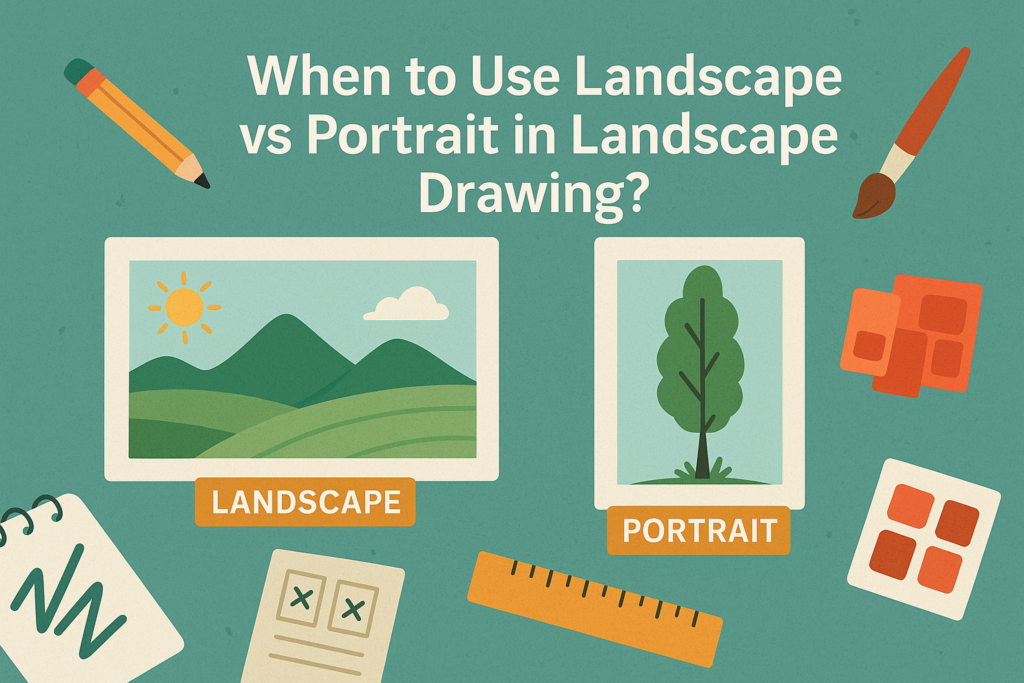Choosing between landscape vs portrait orientation is more than a matter of aesthetics—it influences visual storytelling, technical clarity, and viewer engagement. In the world of landscape drawing, this choice plays a critical role in how the subject is perceived, the emotions it evokes, and the purpose it serves. This comprehensive guide breaks down when and why to use each format, especially for landscape artists, architects, and illustrators.
Understanding Landscape vs Portrait Orientation
What is Landscape Orientation?
Landscape orientation refers to a horizontal layout where the width is greater than the height. It mimics how we naturally see the world—wide and panoramic. It is widely used in landscape design, photography, and architectural rendering.
What is Portrait Orientation?
Portrait orientation is a vertical layout where the height is greater than the width. This format emphasizes height, making it ideal for tall subjects and close-up visual narratives.
For a foundational comparison, read Landscape vs Portrait: What’s the Difference?
Why Orientation Matters in Landscape Drawing
1. Composition and Balance
- Landscape orientation provides ample horizontal space, which supports the composition of wide environments like gardens, valleys, or coastal lines.
- Portrait orientation is ideal when the subject rises vertically—such as tall trees, vertical waterfalls, or stacked garden terraces.
2. Viewer’s Eye Movement
Our eyes naturally move from left to right. A horizontal (landscape) composition supports this flow and feels more comfortable when capturing broad scenes. In contrast, a vertical layout can slow the eye down, emphasizing height and intimacy.
3. Context and Medium
- Printed blueprints, architectural layouts, and digital schematics often default to landscape format.
- Sketchbooks, worksheets, and storyboards frequently use portrait layouts for practicality and segmentation.
When to Use Landscape Orientation in Drawing
1. Capturing Expansive Scenes
Use landscape when illustrating:
- Mountain ranges
- Garden walkways
- Horizon-based compositions
- Wide-angle site plans
2. Supporting Landscape Architecture
Most site plans and professional renderings in landscape design architecture are drafted in landscape orientation for clarity, scaling, and spatial representation.
3. Enhancing Natural Movement
When designing paths, rivers, or architectural flows, a horizontal layout naturally complements the viewer’s directional reading.
When to Use Portrait Orientation in Drawing
1. Highlighting Vertical Elements
Use portrait orientation to emphasize:
- Tree trunks or floral poles
- Fountains and vertical structures
- Garden sculptures or entrance gates
2. Isolating a Focal Element
A vertical layout is ideal when your drawing focuses on a single dominant subject, especially one that rises upward.
3. Educational or Print Settings
Portrait orientation is easier for printing worksheets, creating activity sheets for kids, or designing educational layouts.
Explore more layout styles at Landscape vs Portrait: A Complete Guide to Orientation
How to Choose Between Landscape vs Portrait
1. Match Subject Shape to Orientation
- Use landscape if your subject is wider than tall.
- Use portrait if your subject is taller than wide.
2. Consider Your End Medium
Whether your drawing will be viewed on a screen, printed in a brochure, or submitted for professional review influences the best format.
3. Storytelling and Mood
- Landscape: calm, spacious, cinematic
- Portrait: dramatic, focused, intense
4. Test With Thumbnails
Sketch both orientations before committing to your final design. This helps determine balance and impact.
Use Cases Across Art and Design
| Use Case | Recommended Orientation |
|---|---|
| Panoramic garden drawing | Landscape |
| Drawing vertical structures | Portrait |
| Educational art worksheet | Portrait |
| Concept layout for backyard design | Landscape |
| Instagram post of art process | Portrait |
| Facebook ad showcasing full site | Landscape |
Visual Memory and User Perception
Orientation affects how information is retained and perceived:
- Visual memory is enhanced when layout matches natural eye-tracking.
- Educational drawings or UI for kids benefit from consistent orientation that mirrors their interaction patterns—landscape for readability, portrait for concentration.
Digital Art & Design Considerations
- Instagram portraits and TikTok reels favor vertical formats.
- Facebook covers and YouTube thumbnails prefer horizontal designs.
- Ad layout optimization often involves A/B testing between portrait and landscape.
Final Thoughts: Orientation as a Creative Tool
Choosing between landscape vs portrait in drawing isn’t just a matter of fit—it’s a decision that influences storytelling, viewer experience, and project success. In landscape drawing, where space and form must harmonize, mastering orientation gives your work more power, clarity, and intent.
Anchor articles to continue exploring:

